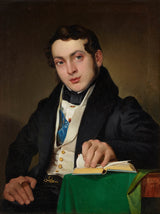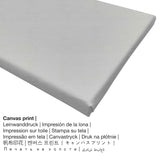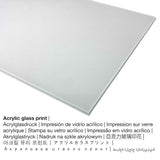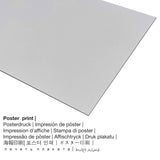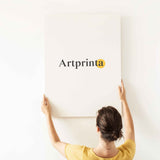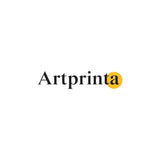Eduard Ritter, 1835 - Ameketi kijana katika sketi nyeusi - uchapishaji mzuri wa sanaa
Kodi ni pamoja. Usafirishaji umehesabiwa katika Checkout.
Supplemental information from Belvedere (© - by Belvedere - Belvedere)
Ritter had been taught at the Vienna Academy of Fine Arts in the years 1829-1834 in the history painting. The first painting, with whom he participated in an academy exhibition (1830, no. 235), was, however, no historical or mythological scene as it could be provided for a student of this subject, but a self-portrait. The stay of this painting is unknown today, but the portrait shown here can a young man, which was created five years later, to give an impression of high artistic level that the young painter had already reached in the 1830s. What is unusual about this depiction is the perspective, because in the foreground the small tables can be seen, only behind the portrayed sitting. Through this game with the optical illusion and the hand shown in excellent shortening that moreover leafing through natural movement in a book, Ritter documented an artistic level, could make the few artists of his time claimed for itself. A suggestion for the space-creating "set piece" in the foreground may be found in the paintings of Gerard Dou (1613-1675), who could know our painters from the Imperial Collection in the Upper Belvedere (today Kunsthistorisches Museum Vienna). Perhaps the "referee" (1529, Kunsthistorisches Museum, Vienna, Inv 783) inspired him by Barthel Beham (1502 to 1540) d or portraits of Hans Holbein. J. (1497-1543), which were available as reproductions. These possible models, however, were very independently implemented in this image and timely adapted. The figure in its overall appearance conveys a unique proximity to life, for instance through the open features, the intelligent-questioning look, the soft molded lips and the relaxed-looking posture. This impression is reinforced by the clear, fresh colors and a painting technique that using fine but easily applied shades modeled the body gently. Unusual is also the folded-back tablecloth by which the attached to the quill of the painter signature becomes visible. [Sabine Grabner, in: Grabner, Sabine: More than Biedermeier. Classicism, Romanticism and Realism in the Austrian Gallery Belvedere, Munich 2006, p 82f]
Maelezo ya kazi ya sanaa
| Jina la uchoraji: | "Sitting young man in a black skirt" |
| Uainishaji: | uchoraji |
| Neno la jumla: | sanaa ya kisasa |
| Karne ya sanaa: | 19th karne |
| Imeundwa katika: | 1835 |
| Umri wa kazi ya sanaa: | zaidi ya miaka 180 |
| Mchoro wa kati asilia: | mafuta kwenye turubai |
| Ukubwa wa mchoro wa asili: | 38,5 x 30 cm - vipimo vya sura: 47 x 38 x 6 cm |
| Sahihi asili ya mchoro: | signed and dated lower right: p knight. / 1835th |
| Makumbusho / mkusanyiko: | Belvedere |
| Mahali pa makumbusho: | Vienna, Austria |
| URL ya Wavuti: | www.belvedere.at |
| Aina ya leseni ya mchoro: | Uwanja wa umma |
| Kwa hisani ya: | © Belvedere, Vienna, nambari ya hesabu: 5028 |
| Nambari ya mkopo: | ununuzi kutoka Dorotheum, Vienna mnamo 1955 |
Maelezo ya msanii muundo
| Jina la msanii: | Eduard Ritter |
| Majina ya ziada: | Eduard Ritter, Ritter Eduard |
| Raia wa msanii: | german |
| Kazi za msanii: | etcher, drawer, artist, lithographer, painter |
| Nchi: | germany |
| Uainishaji wa msanii: | msanii wa kisasa |
| Mitindo ya sanaa: | uhalisia |
| Uhai: | miaka 72 |
| Mzaliwa: | 1820 |
| Mji wa kuzaliwa: | Hamburg, jimbo la Hamburg, Ujerumani |
| Mwaka wa kifo: | 1892 |
| Alikufa katika (mahali): | Vienna |
Vipimo vya bidhaa
| Uainishaji wa makala: | uzazi wa sanaa |
| Njia ya uzazi: | uzazi wa kidijitali |
| Mchakato wa uzalishaji: | uchapishaji wa dijiti (uchapishaji wa moja kwa moja wa UV) |
| Uzalishaji: | kufanywa nchini Ujerumani |
| Aina ya hisa: | uzalishaji kwa mahitaji |
| Matumizi yaliyokusudiwa ya bidhaa: | sanaa ya kuchapisha nyumba ya sanaa, picha ya ukuta |
| Mwelekeo: | muundo wa picha |
| Kipengele uwiano: | 3: 4 |
| Ufafanuzi wa uwiano wa picha: | urefu ni 25% mfupi kuliko upana |
| Nyenzo za bidhaa zinazopatikana: | chapa ya chuma (dibond ya alumini), chapa ya bango (karatasi ya turubai), chapa ya turubai, chapa ya glasi ya akriliki (iliyo na mipako halisi ya glasi) |
| Chaguzi za turubai kwenye fremu ya machela (kuchapishwa kwa turubai): | 30x40cm - 12x16", 60x80cm - 24x31", 90x120cm - 35x47", 120x160cm - 47x63" |
| Uchapishaji wa glasi ya akriliki (na mipako halisi ya glasi): | 30x40cm - 12x16", 60x80cm - 24x31", 90x120cm - 35x47" |
| Chapisho la bango (karatasi ya turubai): | 30x40cm - 12x16", 60x80cm - 24x31", 90x120cm - 35x47" |
| Vibadala vya ukubwa wa dibond ya Alumini (nyenzo za alumini): | 30x40cm - 12x16", 60x80cm - 24x31", 90x120cm - 35x47" |
| Muundo wa nakala ya sanaa: | si ni pamoja na |
Chagua chaguo lako la nyenzo
Kwa kila bidhaa tunatoa ukubwa tofauti na vifaa. Chaguzi zifuatazo zinapatikana kwa ubinafsishaji:
- Chapa ya chuma (dibond ya alumini): Aluminium Dibond prints are metal prints with a true effect of depth. A direct Aluminium Dibond Print is the ideal start to art reproductions with aluminum. The colors of the print are bright and luminous in the highest definition, the details of the print appear crisp and clear. The UV print on aluminium is the most popular entry-level product and is a stylish way to showcase fine art reproductions, because it draws attention on the replica of the artwork.
- Uchapishaji wa turubai: A canvas print, not to be mistaken with an artwork painted on a canvas, is an image printed onto cotton canvas. The canvas produces a soft and comfortable look. The great advantage of canvas prints is that they are relatively low in weight. This means, it is easy and straightforward to hang up the Canvas print without any wall-mounts. Because of thata canvas print is suited for all kinds of walls.
- Chapa ya bango (nyenzo za turubai): The Artprinta poster is a printed cotton canvas with a granular surface finish, that reminds the actual version of the artwork. Please note, that depending on the size of the poster we add a white margin between 2-6cm around the print motif, which facilitates the framing with a custom frame.
- Chapisha kwenye glasi ya akriliki yenye kung'aa (iliyo na mipako halisi ya glasi): An print on acrylic glass, often named a UV print on plexiglass, will turn your favorite original into beautiful décor. The artwork will be made thanks to the help of state-of-the-art UV print technology. The major upside of an acrylic glass print is that contrasts and also granular image details become visible due to the very fine tonal gradation of the picture.
Vipimo vya bidhaa za sanaa
Sitting young man in a black skirt is an artwork made by the German painter Eduard Ritter katika mwaka 1835. The 180 year old version of the work of art was painted with the size: 38,5 x 30 cm - frame dimensions: 47 x 38 x 6 cm. Mafuta kwenye turubai was applied by the artist as the technique for the artwork. The original artwork has the following inscription: signed and dated lower right: p knight. / 1835th. This piece of art belongs to the Belvedere's art collection in Vienna, Austria. Hii Uwanja wa umma artwork is being included with courtesy of © Belvedere, Vienna, inventory number: 5028. : purchase from the Dorotheum, Vienna in 1955. What is more, the alignment of the digital reproduction is picha ya na ina uwiano wa kipengele cha 3: 4, meaning that the length is 25% shorter than the width. Eduard Ritter was a artist, painter, etcher, drawer, lithographer of German nationality, whose artistic style can be classified as Realism. The artist was born in 1820 in Hamburg, Hamburg state, Germany and passed away at the age of 72 katika mwaka 1892.
Legal disclaimer: We try the best we can to depict the art products with as many details as possible and to illustrate them visually. Nonetheless, the colors of the print products, as well as the print result can vary somehwat from the presentation on your monitor. Depending on the settings of your screen and the condition of the surface, not all color pigments can be printed as exactly as the digital version depicted here. Bearing in mind that all the art reproductions are printed and processed by hand, there may also be minor variations in the motif's exact position and the size.
© Hakimiliki ya - Artprinta.com (Artprinta)

